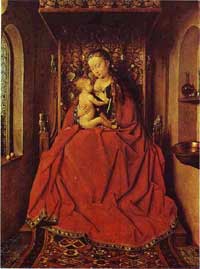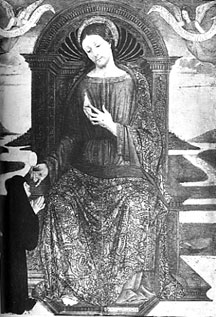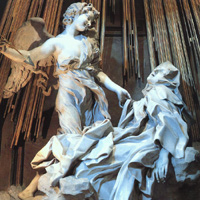
Ecstasy of St. Teresa
by Gianlorenzo Bernini
Santa Maria della Vittoria,
Rome (1647-52)
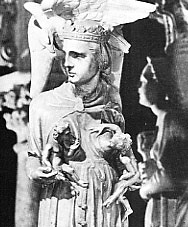
Giovanni Pisano
represents the Church
as lactating mother
in this marble pulpit
in the Cathedral
at Pisa (d. 1314)
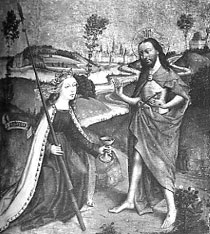
Eucharistic
Man of Sorrows
with allegorical figure
Charity
(1470)

Lactation of St. Bernard
from Retable of
St. Ildefonso
by Master of
Osama (1460)
Christian
Cannibals....
3BACK
| HOME | NEXT4
_________________________________________________________
Whereas Ann Rice merges desire and death in cannibalistic images that
depict a sense of doom through blood sacrament, many Medieval women merged
desire and death with resurrection and wholeness in cannibalistic imagery
that seemed to allow them to express feminine ecstasy in a religious culture
that would have otherwise sought to suppress it. In her book Holy Feast
and Holy Fast: The Religious Significance of Food to Medieval Women,
Caroline Walker Bynum points out that many Medieval women experienced
the Eucharist (body and blood of Christ eaten in communion) in ecstasy,
likening it to an erotic union with Christ. Bynum quotes several passages
written by such women (both laywomen and saints), one of which comes from
fourteenth-century layperson Marjory Kempe, who thought Christ said to
her:
| Daughter, thou desirest greatly to see Me, and thou mayest boldly, when thou art in they bed, take Me to thee as thy wedded husband, as thy dearworthy darling, and as thy sweet son, for I will be loved as a son should be loved by the mother, and I will that thou lovest Me, daughter, as a good wife ought to love her husband. Therefore thou mayest boldly take Me in the arms of they soul and kiss My mouth, My head, and My feet, as sweetly as thou will. And as often as thou thinkest of Me, or wouldst do any good deed to Me, thou shalt have the same reward in Heaven, as if thou didst it to Mine own Precious Body which is in Heaven (Bynum 247). |
The crossing of role boundaries here (mother/daughter/lover of Christ), and the parallel crossing of flesh boundaries in the partaking of the Eucharist, do not necessarily represent dysfunction as they do in contemporary vampire mythology (although it has been argued that Eucharist ecstasy and other spiritual experiences were constructs by many women who were indeed coping with dysfunctional families--Bynum 198). Experiences like the one reported by Margery Kempe above seem to more aptly represent transcendence of traditional female gender roles--i.e., the Eucharist ecstasy produced by the symbolic union with Christ transcends the sex act itself. Bynum suggests that it historically transcended other activities associated with women's roles as well. For example, "Wives and daughters used fasting, charity, and ecstasy to escape the role of food preparer or nurturer," she explains. "Dorothy of Montau, like Margery Kempe, made elementary mistakes in cookery (such as failing to scale the fish before frying them) or forgot entirely to cook and shop while she was in mystical trances" (Bynum 221).
When the tables turn and woman as religious figure becomes cannibalized, she becomes Christ-like herself, rather than a subject of patriarchal control. The traditional role of mother is elevated. The church, for example, is often seen as a lactating mother by medieval writers and artists. A marble pulpit in The Cathedral at Pisa, sculpted by Giovanni Pisano (d. 1314), for example, shows a woman nursing two Christians (Bynum, Plates II, figure 17). Moreover, Christ's wound has been likened to a nipple in many medieval works. For example, in Eucharist Man of Sorrows with the allegorical figure Charity (Bynum, Plates II, figure 26), Christ fills a Eucharist cup with a fountain of blood from his breast. This imagery reminds us of depictions of the Virgin filling St. Bernard's mouth with a fountain of her breast milk (Bynum, Plates II, figure 18). Overall, women became Christ-like in their ability to feed from their bodies.
Below, Christ's
wounded breast, in Quirizio da Murano's The Savior (Plates II,
figure 25), reminds us of the Virgin Mary's breast in Jan van Eyck's famous
Lucca Madonna (Bynum, Plates II, figure 24).
|
Lucca
Madonna |
The
Savior by Quirizio |
__________________________________________________________
CONTINUE
4
